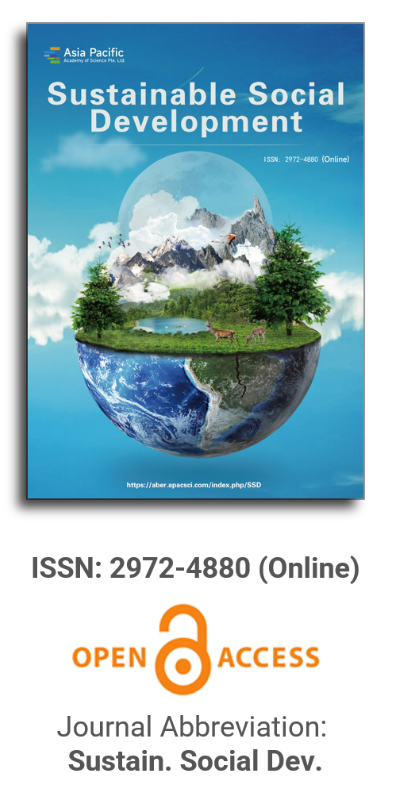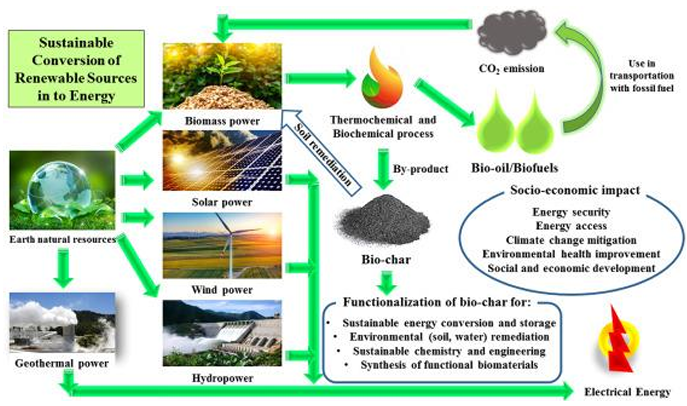
Asia Pacific Academy of Science Pte. Ltd. (APACSCI) specializes in international journal publishing. APACSCI adopts the open access publishing model and provides an important communication bridge for academic groups whose interest fields include engineering, technology, medicine, computer, mathematics, agriculture and forestry, and environment.

Global challenges like climate change and resource depletion have created an urgent need for renewable energy resources and international cooperation to ensure environmental resilience. This issue delves into the challenges of ecological system destruction, diminishing climate actions and lack of standardized sustainability metrics. The adoption of renewable energy in today’s advanced technological surroundings is essential to manage energy use and efficiency, along with integrating sustainability elements into project planning and execution to generate positive impact. Additionally, several nation-focused works include assessing the geographical distribution of agriculture products to understand region performance, studying the economic security levels to evaluate quality of life, and analyzing gender roles in managing agroforestry practices. The works in this issue provide insights for advancing sustainable development, through integrating clean technologies and conservational efforts to achieve more sustainable outcomes.
Full Issue
| View or download the full issue |
Issue release: 30 April 2025
Issue release: 30 April 2025
Geographical Indications (GIs) are one of the important types of Intellectual Property Rights (IPRs) that are based on the geographical region. In light of this, the geographical region is vital for innovation to develop the regional economy and significant to understanding innovative performance in the particular region. With this context, the objectives of the paper are 1) to assess GIs products and sketch the historical development of GI in India; 2) to explore the scenario of agriculture products registered under the GIs; and 3) to address challenges of GIs during registration. Furthermore, the study is based on secondary data obtained from the Geographical Indication Registry of India. Findings: The study shows that the number of agricultural product registrations has increased in the last few years. This increase may be attributed to the new IPR policy regime and heightened public awareness.
Issue release: 30 April 2025
Quality of life indicators are significant tools to evaluate the individual’s well-being. In this sense, economic security measurement is a part of well-being. In achieving a greater level of well-being, countries can get many benefits by joining economic integrations. However, these benefits may not only sometimes be as great as thought. We investigate the changes in (in)security measurements for the new members with the difference-in-difference method. This method is beneficial for analyzing the effects before and after treatment, policy, and implications for different units. Our study aims to detect if there are significant changes or improvements in the security levels of new members of the European Union from 2005 to 2022. The findings figure out that the level of arrears was essentially reduced for most members. Still, the integration has no visible impact on purchasing power parity for the period. These are critical findings showing a trend not sourced from integration and, at the same time, the inefficiency of policy and implementation of the EU.
Issue release: 30 April 2025
Energy resources are critical drivers of economic development and societal progress, but their extraction, conversion, and use have profoundly impacted ecological systems and the environment. Therefore, it is essential to explore the relationships between energy resources and the environment throughout history. This paper examines the causal relationships between energy resource utilization and environmental changes, addressing both renewable and non-renewable energy sources. We analyze the environmental consequences of energy extraction and consumption, including pollution, habitat destruction, and climate change, and evaluate sustainable approaches to mitigate these effects. Fossil fuels have been the primary source of energy and are major contributors to greenhouse gas emissions, air and water pollution, and habitat destruction, all of which exacerbate global climate change. On the other hand, renewable energy sources such as wind, solar, and hydroelectric power are considered more sustainable. However, they also have environmental impacts, such as habitat disruption and high resource consumption. Researchers argue that trade-offs must be managed between increasing energy use, facilitated by technological advancements, and achieving sustainability. Energy generation and ecological goals should not be viewed as opposing or irreconcilable. With the implementation of appropriate policies, measures, and guidelines, energy production can be aligned with efforts to mitigate climate change and promote sustainability.
Issue release: 30 April 2025
Agroforestry holds significant promise for offering substantial benefits to the Garo ethnic community, who are recognized as one of the primary indigenous groups in the Madhupur region with distinct cultural identities. Given the integral role of community involvement in agroforestry management, particularly in relation to gender dynamics, this study sought to analyze the gender role of Garo men and women in adopting and managing agroforestry practices. Data were gathered from 70 Garo tribal farmers (37 male and 33 female) across six villages practicing various agroforestry techniques in the Madhupur Sal forest area. Using a mixed-methods approach that incorporated semi-structured questionnaires, focus group discussions, key informant interviews, and direct observations, the study identified prevalent agroforestry practices featuring various tree-crop combinations. These included Akashmoni (Acacia auriculiformis) paired with Pineapple (Ananas comosus) and Ginger (Zingiber officinale), as well as other combinations such as Akashmoni-Pineapple-Turmeric, Akashmoni-Pineapple-Papaya, and Akashmoni-Pineapple-Aroid. Both men and women exhibited a moderate to high level of involvement in agroforestry programs, with decision-making processes shared between genders. However, challenges were encountered, particularly by women from ethnic minority backgrounds, including limited technical knowledge, financial resources, and labor availability. Despite these obstacles, both Garo men and women expressed a keen interest in agroforestry practices as a means to enhance their income and livelihoods, forming gender-based partnerships to address associated challenges in a changing socioeconomic landscape.
Issue release: 30 April 2025
Since the 1970s, the role of trade liberalization and foreign direct investment in promoting environmental sustainability has been a hot topic in academics. While some research supports the Porter hypothesis, others support the pollution-haven hypothesis. Accordingly, this study aims to determine whether the pollution haven hypothesis holds by examining how trade openness and foreign direct investment affect Nigeria’s environmental sustainability for the period of 1981 to 2021. By deploying the dynamic ordinary least square (DOLS) estimation technique, the study outcomes indicate that trade openness and foreign direct investment have a negative and significant long-term effect on Nigeria’s greenhouse gas emissions. Therefore, the results of this study support the Potter hypothesis, which holds that emerging nations become centers of advanced and cleaner technology as a result of trade liberalization and foreign direct investment. As a result, the study suggests that the Nigerian government should support the creation of compressed natural gas (CNG) stations and the switch to CNG-powered vehicles. The Nigerian government can also promote investment in the green energy industry by offering tax holidays and other benefits to companies in this field. Furthermore, there should be a widespread public education campaign on the threat posed by global warming and the necessity of planting trees to mitigate the effects of climate change and discourage tree-cutting.
Issue release: 30 April 2025
Coordinated actions to protect biodiversity, incorporate renewable energy, and implement climate action are needed for sustainable development to be achieved in the context of global challenges like climate change, ecosystem destruction, and resource depletion. Climate action seeks to reduce the negative impact and strengthen the adaptive capacity of natural and human society. Climate action includes both adaptation and mitigation strategies. The transition to renewable power sources is of utmost importance to climate action because it helps to slow environmental degradation, curtail fossil fuel dependence, and significantly diminish greenhouse gas emissions. The adoption of renewable energy, such as solar, wind, and hydropower, is more environmentally friendly than conventional energy sources, but it may also pose potential risks towards biodiversity, so measures should be taken in planning to avoid negative environmental impacts. It is crucial to protect biodiversity around the world because it plays an important role in the delivery of ecosystem services such as soil fertility, pollination, water purification, and the sequestration of carbon that are vital to people’s existence. In addition, strong ecosystems reduce the severity of climate change impacts, such as storms, droughts, and flooding. However, there may be trade-offs when striving for the increase of renewable energy and biodiversity conservation. Renewable energy development should always be complemented with biodiversity protection. This approach preserves the environmentally delicate ecosystems that are crucial to achieving climate action targets. The combination of climate action, renewable energy, and the need for biodiversity makes it possible to reap many benefits. These include stronger ecosystems and better human health, as well as economic growth and job creation. One example of such a nature-based solution is agrovoltaics, which combines solar energy production and farming. Restoring ecosystems, like forests or wetlands, can also greatly enhance carbon sequestration, reduce global warming, and protect endangered wildlife. This strategy aligns with international initiatives such as the United Nations Sustainable Development Goals (UN SDGs), specifically SDGs 7, 13, and 15. It serves as a building block towards a more sustainable future. Despite the clear possibilities of synergy, there are still barriers that must be tackled. Policy fragmentation, resource competition, and lack of inter-sector cooperation are some of the challenges that inhibit effective integration. Therefore, equitable governance and the adoption of nature-based techniques are essential.
Issue release: 30 April 2025
The pursuit of sustainable project management practices is becoming increasingly important in contemporary project management discourse. This review explores the integration of sustainability principles and environmental considerations within project management frameworks, aiming to identify specific strategies that lead to eco-friendly project outcomes and foster long-term sustainability. By examining a broad range of scholarly works, empirical studies, and industry reports, this review highlights key methodologies for embedding environmental consciousness into project planning, execution, and evaluation. The findings reveal that incorporating sustainability principles into project management not only enhances project outcomes but also significantly reduces adverse environmental impacts. Specifically, the review identifies effective approaches such as life cycle assessment (LCA) and stakeholder engagement, which are shown to be instrumental in promoting sustainable practices across different project stages. Moreover, the study sheds light on common challenges, such as resistance to change and the lack of standardized sustainability metrics, and offers actionable recommendations for overcoming these barriers. In addition, the review discusses opportunities for advancing sustainable project management through the application of emerging technologies and cross-disciplinary collaboration. Insights from behavioral studies, environmental sciences, and management theories provide a comprehensive understanding of the factors driving the successful adoption of sustainability practices among project stakeholders. Ultimately, this review consolidates theoretical perspectives and empirical evidence to present a clear and detailed understanding of how sustainable project management practices can be effectively implemented to achieve environmentally responsible and enduring project outcomes.

Prof. Kittisak Jermsittiparsert
University of City Island, Cyprus






It is with deep regret that we announce the cancellation of the Forum on Sustainable Social Development & Computing and Artificial Intelligence, originally scheduled for June 15, 2025.


 Open Access
Open Access